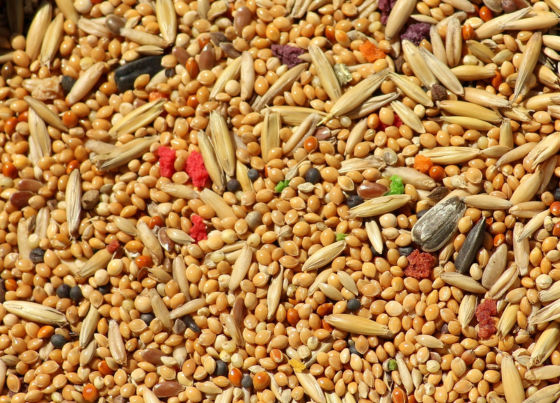Farmers look for alternatives to climate-change impacted wheat
Here's how crop diversification can combat climate change and enhance nutrition in India, and how climate-smart crops such as millets can ensure food security and sustainable farming.
In 2022, 75-year-old Ali, a farmer in Uttar Pradesh, lost 35 percent of his wheat crop sowed in his two-hectare field due to a heatwave, and the remaining crop suffered in terms of quality.
His neighbour was luckier as he opted to sow mustard along with wheat, thus compensating the losses to an extent. “…wheat and paddy are staple crops that we grow. We can change our pattern for a year but that cannot be the case every year. We just do not know how the weather will be next year," 54-year-old Kamal told a news agency in August 2022.
The extreme weather pattern is a series of continuous climactic changes farmers have grappled with as they come to terms with the impact of global warming on an occupation that is almost entirely dependent on predictable weather. Climate change is increasingly affecting grain crop growth, largely in negative ways, due to higher surface temperatures and more frequent and severe extreme weather events.
The agricultural sector is crucial for enhancing food security amidst rising global populations. In 2020, it was reported that approximately 690 million people, or 8.9% of the world's population, was facing hunger.
By 2050, it is projected that there will be a need to increase food production by 70% to sustain an estimated 9 billion people. Developing nations, heavily reliant on agriculture, are especially at risk from climate change impacts, which threaten to lower agricultural productivity and increase food demand, leading to greater income and food insecurity. Studies forecast a significant reduction in global welfare and GDP by 2050 — around USD 268 billion and USD 265 billion respectively — due to decreased agricultural outputs caused by climate impacts.
The Sixth Assessment Report by the Intergovernmental Panel on Climate Change (IPCC) identifies food security, specifically grain security, as a critical risk.
In India, agriculture employs over half of the workforce, highlighting its significance to the country's economy.
The impact of global warming on the country’s agricultural productivity by the 2080s will be particularly severe, with projected crop losses ranging from about 30 to 40 percent, reflecting its geographical vulnerability due to its proximity to the equator, according to an article published in International Monetary Fund’s Finance & Development magazine.
The article also pointed out that a technological rescue to increase food production to combat the impact of climate change is a pipe dream as data from the UN Food and Agricultural Organization indicates that growth in grain production tapered to 1.6 percent annually over the last 25 years, compared with 2.7% increase seen in the 1960s and 70s.
Indian farmers are now considering alternatives – hardy crops that can survive a harsher climate as well as provide the nutritive elements of traditional favourites.
India and its crops
India is the world’s second largest wheat producer, with more than 40% increase in its production since 2000 and more than 99% of its output used to feed its residents. Yet, with the mercury rising, there's growing unease about how well wheat can cope with the heat.
The country experienced an extended heatwave in March 2022, the steepest since the country’s temperature record-keeping began in 1901, resulted in lower than the expected wheat production, by around 4.5 million tonnes, according to an April 2023 news report.
2023 flipped the script – but it wasn’t for the better. The country’s wheat production drowned under excessive rainfall in March – right when the crop enters the vital grain-filling stage and harvesting in April.
Aiming for a 5% increase in 2023, India targeted 112 million tonnes of wheat planting across 34 million hectares. However, key wheat-producing states, especially Punjab and Haryana, experienced rainfall exceeding expectations by 205% and 220%, respectively, adversely impacting the crop.
Wheat's sensitivity to temperature has been researched extensively, showing that temperatures beyond the optimum levels can harm its growth and development stages. Ideal temperatures vary from 17°C for root growth to 26°C for grain filling. This means Indian farmers grow wheat during the dry winter season after the monsoon, known as the rabi season, often alternating with rice from the monsoon or kharif season.
Meanwhile, sorghum (colloquially known as jowar), placed fifth in global cereal production behind maize, rice, wheat, and barley, is cultivated in India across both rabi and kharif seasons. Sorghum is also a less thirsty crop, compared with wheat requiring lesser water across all growth phases.
The United States Department of Agriculture tested a hybrid variety of sorghum under mild deficit irrigation and found it exhibited minimal water stress. Due to increasing water scarcity in the Texas High Plains, farmers favoured planting sorghum versus corn. Sorghum's drought tolerance and ability to yield more under drought conditions made it a preferable option, especially as droughts and water shortages led to significant corn losses, according to research published in 2015.
A February 2021 study published in the journal Foods shows that, sorghum stands out as a crucial crop in Sub-Saharan Africa (SSA) due to its remarkable drought tolerance and nutritional profile, offering a potent solution to the region's pressing food and nutritional insecurity.
In SSA, where agriculture largely depends on erratic and insufficient rainfall, and a significant portion of the land is arid or semi-arid, sorghum's ability to yield reasonable harvests under water scarcity is invaluable. Further, sorghum’s high content of proteins, iron, and zinc addresses the critical "hidden hunger" affecting SSA communities.
The 2021 study observed that sorghum’s importance in SSA is amplified by the challenges of low, unpredictable rainfall that affects crop production and yields, driving a need for crops that can thrive under such conditions. It cites the concept of nutritional water productivity (NWP focusing on maximising the nutritional output per unit of water used, which in turn highlights the need for integrating crop yield and nutritional quality under water-limited conditions, a criterion that sorghum meets due to its drought resilience and nutrient density.
A February 2024 study examined the impact of climate change on sorghum yields in Myanmar, focusing on the period from 1997 to 2020, showing the temperature positively influences sorghum yield in both the short and long term. Conversely, rainfall negatively affects yield in the long run, whereas carbon dioxide levels have a positive impact on yield in both time frames.
The “Camel of Cereals”
The United Nations General Assembly, in March 2021, declared 2023 the International Year of Millets.
Qu Dongyu, the Director-General of the UN's Food and Agriculture Organization, said that the nutritive value of millets and their invaluable role in empowering small farmers, tackling food security issues and achieving sustainable development, according to a February 2023 BBC article.
In response to the UN resolution, India has introduced several schemes to, “enhance production and productivity, consumption, export, strengthening value chain, branding, creating awareness for health benefits etc.,” according to an August 2023 press release.
India’s major millet crops are jowar, bajra, and ragi, totalling 423,675 metric tonnes of jowar, 758,094 metric tonnes of bajra, and 1,676,067 metric tonnes of ragi with Rajasthan, Uttar Pradesh, Karnataka, and Maharashtra being the top five millet producing states in 2022-23.
Historically, millets’ demand waned as the government focused on wheat and rice production, both for domestic consumption and export. “Being officially called a "coarse grain" didn't help millets' cause either, as this designation signified something less desirable to processed rice and wheat,” the BBC article notes.
However, millets are slowly making their way back to Indian plates – whether humble or fancy – in various ways. Influential restaurant chefs are finding ways to incorporate the grain in their menus by camouflaging it under fusion recipes.
Companies such as Tata Soulfull and Slurrp Farms are also capitalising on the millet trend by offering millet-based products, including snacks and ready-to-eat meals like chips, chakli (a savoury snack traditionally made from rice and lentils), noodles, pancake mixes, and breakfast cereals.
A 2021 study published in Environmental Research Letters showed that that boosting the presence of millets in worldwide diets by 10 percent could lead to significant dual advantages, enhancing nutrient intake and decreasing environmental impacts.
Indian School of Business’ Associate Professor Ashwini Chhatre says that India needs to advocate for diversification of cereals and push for millet production for both nutrition and climate adaptability.
"Jowar, due to its robustness and lower water needs compared to wheat, has the potential to significantly alter and alleviate the effects of climate change on agriculture in India," Prof. Chhatre said, emphasising the critical necessity for adopting climate-smart agricultural practices, especially in the rabi season.
India’s Ministry of Agriculture & Farmers Welfare, on 21 March 2023, said that it recognized the effects of climate change on agriculture and the livelihood of farmers. It conducted extensive field and simulation studies across the country, assessing the impact of climate change using crop simulation models for the years 2050 and 2080.
Without adopting adaptation measures, it projected that rainfed rice yields would decrease by 20% in 2050 and 47% in 2080, while irrigated rice yields would see a reduction of 3.5% in 2050 and 5% in 2080. Wheat yields were expected to drop by 19.3% in 2050 and 40% in 2080, with kharif maize yields decreasing by 18% and 23% in the respective scenarios. Climate change was seen to not only diminish crop yields but also to lower the nutritional quality of the produce, with extreme weather events like droughts impacting food and nutrient consumption and affecting farmers severely.
In response, the Indian government started schemes and plans to make agriculture more resilient to climate change. The National Mission for Sustainable Agriculture (NMSA), part of the National Action Plan on Climate Change (NAPCC), aimed to develop and implement strategies for making Indian agriculture more resilient to climate change.
References
- https://economictimes.indiatimes.com/news/economy/agriculture/experts-link-recent-drop-in-wheat-production-to-climate-change-urge-india-to-take-it-up-at-cop27/articleshow/93834002.cms?from=mdr
- https://journalofeconomicstructures.springeropen.com/articles/10.1186/s40008-023-00320-z
- https://www.mdpi.com/2304-8158/13/6/966
- https://thewire.in/agriculture/india-wheat-crop-hit-untimely-rain
- https://agresearchmag.ars.usda.gov/2015/jul/water/
- https://www.mdpi.com/2304-8158/10/2/385
- https://www.researchgate.net/publication/378683547_Exploring_the_short-and_long-run_effects_of_climate_change_on_Sorghum_Sorghum_bicolor_yield_in_Myanmar
- https://www.fao.org/millets-2023/en
- https://www.bbc.com/travel/article/20230208-why-2023-is-the-year-of-millets
- https://pib.gov.in/PressReleaseIframePage.aspx?PRID=1947884
- https://www.bbc.com/travel/article/20230208-why-2023-is-the-year-of-millets
- https://iopscience.iop.org/article/10.1088/1748-9326/ac32fc
- https://pib.gov.in/PressReleaseIframePage.aspx?PRID=1909206



